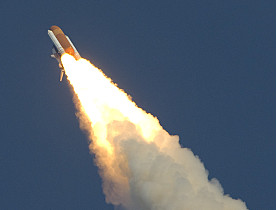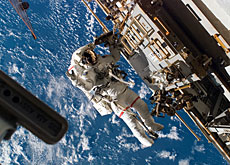Swiss space technology pursues European dream

The European Space Agency launched on Sunday its first unmanned transport vehicle on a groundbreaking mission to the International Space Station (ISS).
Swiss engineering will play an important role in this initial flight, which will see the ATV module, dubbed Jules Verne, deliver essential supplies and new scientific experiments to the station.
The unmanned freighter left the Kourou spaceport in French Guiana at 0403 GMT, riding on top of an Ariane 5 rocket.
Oerlikon Space, the country’s leading space firm and a major sub-contractor in the project produced components for the craft including the payload fairing and cargo racks, spokesman Hendrik Thielemann told swissinfo before the launch.
Around 20 of the company’s engineers and specialists have been taking part in the project, which replaces the Russian-built Progress, a smaller type of “space barge”.
The ATV weighs 20 tons, and with a length of ten metres, is roughly the size of a London double-decker bus.
A protective helmet
As the rocket carrying the module heads over the Atlantic Ocean from its launch point and into space, the fairing will serve as a sort of helmet for the precision instruments inside.
The lightweight aluminium-composite cap protects against mechanical stress, heat, as well as space debris and meteorites, according to Oerlikon. The spacecraft has undergone five years of testing.
“Everything has to be done with very low tolerances and with very high quality and reliability,” Thielemann added. “For this, everything is tested again to make sure nothing will go wrong in space.”
The ATV will circle the planet several times for five days before linking with the ISS, 400 kilometres above the Earth.
Radars, sensors and satellite data onboard the module will gradually align it with the ISS over the coming days, at which point it will connect with a Russian-made docking station. ATV programme manager John Ellwood predicts that the manoeuvre will resemble “a graceful dance”.
Swiss partners
Oerlikon is the largest – but not the only – Swiss firm in this complex international relationship, Peter Erni of the State Secretariat for Education and Research’s space division told swissinfo. Other contractors include Pilatus Aircraft and Ruag Aerospace.
Erni added that while the Swiss space industry is relatively small compared with its larger European counterparts, firms here have responded by developing specific areas of expertise.
This has allowed them to become world leaders in technologies including atomic clocks, which are utilised in space programmes around the world.
Swiss companies have taken on a disproportionately higher role in the mission, Erni said. But like all good things, the Jules Verne – the non-literary version – must also come to an end.
Astronauts aboard the ISS will begin offloading cargo and filling the empty space with waste. After six months and as many metric tons of trash, the Jules Verne will detach itself and head towards earth, where it will burn up in the atmosphere.
swissinfo, Justin Häne
The Jules Verne, named after the French science fiction author, is the first of five ATVs planned to visit the ISS between now and 2015.
The primary contractor for the project is the French-German aerospace corporation Eads, which also produces satellites and is the parent company of Eurocopter and Airbus.
The ATV project required close international and inter-company cooperation, including regular progress meetings and constant dialogue between engineers.
The structure of the ATV weighs two tons, but during launch, it carried the entire 20-ton weight of the module.
Immediately after liftoff and during its journey into space, the structure endured forces five times greater than gravity, due to acceleration making it feel more like 100 tons.

In compliance with the JTI standards
More: SWI swissinfo.ch certified by the Journalism Trust Initiative











You can find an overview of ongoing debates with our journalists here . Please join us!
If you want to start a conversation about a topic raised in this article or want to report factual errors, email us at english@swissinfo.ch.